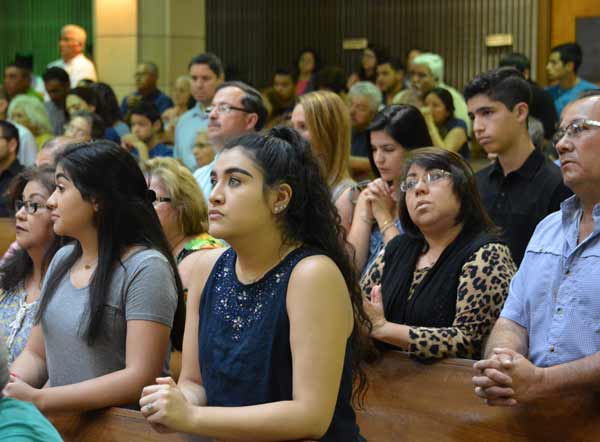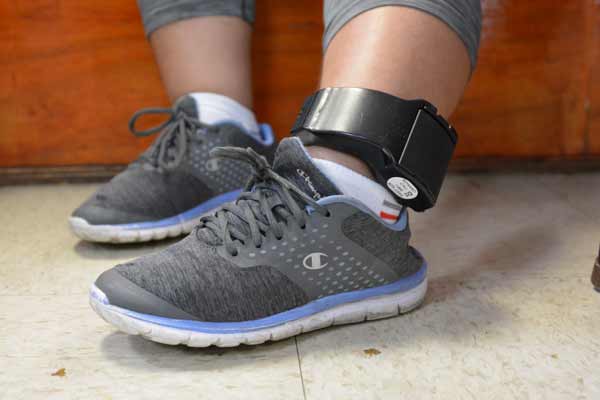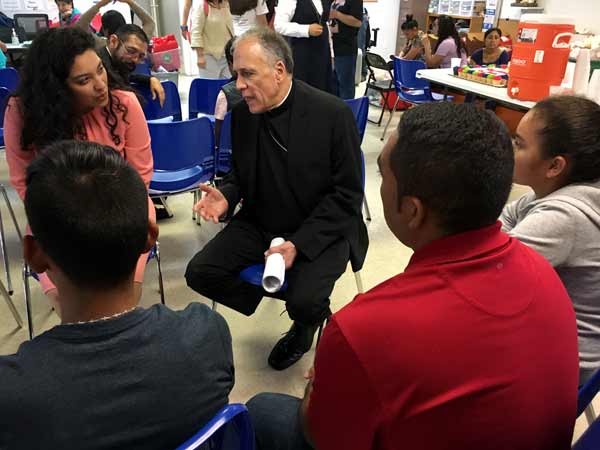
By Jorge I. Dominguez
“We are a nation of laws, and we are also a nation of compassion.” That was the mantra of a two-day visit, July 1-2, by a delegation of the U.S. Conference of Catholic Bishops (USCCB) to the epicenter of the immigration crisis – the Brownsville-McAllen area of Texas, right on the Mexico border.
The president of the USCCB, Cardinal Daniel N. DiNardo of Galveston-Houston, Texas, was the main celebrant at a bilingual Mass celebrated Sunday morning at the Basilica of Our Lady of San Juan del Valle-National Shrine in San Juan city. The homilist was Bishop Daniel E. Flores of Brownsville.
As part of the delegation, Auxiliary Bishop Robert J. Brennan of Rockville Centre, L.I., and Bishop Joseph C. Bambera of Scranton, Pa., concelebrated the Mass with Cardinal DiNardo. Bishop Raymundo Joseph Peña, bishop emeritus of Brownsville, also concelebrated.
Bishop Flores compared the visit of the bishops’ delegation with the healing of the daughter of Jairus as told in the Gospel reading of the day. He said: “What kind of people does the Lord want? He wants a people capable of looking at the reality in front of them and adapting to that reality. He didn’t say, ‘I don’t have time for you today.’ He didn’t say, ‘You’re not in the plan, you’re not in the calendar.’”
More than 2,000 people filled the basilica, the second most visited shrine in the U.S. after the Basilica of the Immaculate Conception in Washington, D.C. With almost a million Catholics, Brownsville has the highest percentage of Catholics to total population in the U.S.: 85 percent of people living in the diocese are Catholic. Hispanics make up 85 percent of the total population.
Talking about a crisis that has often been used to score political points on both sides of the aisle, Bishop Flores highlighted the human side of the problem. That is the role of the Church, he said.
“We as a Church have to hear where the reality is, we have to be the ones to say, ‘There’s a human face and that human face always points us to Christ.’ If we don’t say it, who will?”

Restoring Human Dignity
The bishops then visited the Humanitarian Respite Center of the Catholic Charities of the Rio Grande Valley. The tag line of the center is “Restoring Human Dignity.”
The center was recently relocated to a small building three blocks from the McAllen Central Station, where immigrants arrive after being detained and processed by the U.S. Immigration and Customs Enforcement (ICE).
Brenda Nettles Riojas, diocesan relations director for the Diocese of Brownsville, explained that asylum seekers are usually detained by ICE at the border and then sent to detention centers, where they are processed and get electronic ankle bracelets. Afterward, they are bused to the Central Station.
But most of them don’t know what to do next. They are thirsty and hungry. They have been traveling for weeks in harsh conditions. And they don’t speak English. Many of them don’t know how to get a bus ticket or even have the money to buy one.
Volunteers from the respite center go to the station when immigrants arrive and bring them to the center. There, they receive water, food and clothes if they need them. They can take a shower and a nap on the floor mats – there are no beds due to the influx of migrants and lack of space.
Then volunteers help newcomers get a bus ticket to the city where they are headed to stay with family or friends. But the essence of the Catholic Charities effort is indeed “to restore human dignity.” The immigrants are received at the center with applause, smiles and welcoming words in Spanish. It is probably the first time they feel welcomed in the United States and are treated more like human beings in need of help, than as problems to be avoided.
Sister Norma Pimentel, M.J., executive director of Catholic Charities of the Rio Grande Valley, is the driving force of these efforts. After welcoming the bishops’ delegation to the center and explaining what they do there, she said to Cardinal DiNardo: “We’re putting you to work, cardinal.” And soon enough, all of the bishops were talking to the immigrants, listening to their stories and comforting them – trying to restore human dignity.
Archbishop José H. Gómez of Los Angeles, Calif., vice president of the USCCB, joined the delegation to visit and celebrate Mass for some 250 children at the Casa Padre Center – a Department of Health and Human Services detention center located in a former Walmart store.
“It was challenging to see the children by themselves,” Archbishop Gomez said after Mass. “Obviously, every Sunday when we have children at Mass they are there with their parents, with their families. … But it was a blessing to be there and give them some hope.”
The idea of sending a delegation of bishops to the U.S.-Mexico border to inspect detention facilities and offer a sign of solidarity was proposed at the Catholic bishops’ conference annual spring assembly last month.
“Our visit is a pastoral visit, pastoral in nature,” Cardinal DiNardo explained at a news conference as the delegation wrapped up its trip.
The cardinal thanked the Diocese of Brownsville and ICE officials for their collaboration to facilitate the visit to the detention center.
And he also talked about the civility and collaboration needed to deal with the immigrant crisis.
“We all need to cool our rhetoric and approach one another,” he said. “I have plenty of people in my local church who are very traditional in faith and very conservative, even politically, but who are moved by the sight of the emigrant children.”

Bishop Bambera spoke about how personal encounters can change perspectives, and move people beyond labels to true understanding.
“When you have the opportunity to sit down with a family, liberal labels and conservative labels melt away. When you talk to somebody whose deepest desire is not to exploit a country, or grab anything that they can, but simply provide for their children and to keep their children safe, the labels just melt away.”
The bishops then asked for concrete steps to solve the crisis. The tone was amicable when talking about the government, but there was a clear demand on the part of the bishops.
“The children who were separated from their parents need to be reunited,” Cardinal DiNardo said. “That’s already begun – and we are pleased with that – but it’s certainly not finished and there may be complications, but it must be done and it’s urgent. …
“We are a nation of laws, we are also a nation of compassion. Yes, we need to get the children back with their parents – it is really crucial.”
‘A Matter of Humanity’
Archbishop Gómez added, “It’s not just a matter of politics, it is a matter of humanity. … We want something from this administration, from Congress – it is family unity, because that’s essential for the human person.”
For the cardinal, the way ahead shouldn’t be a confrontation with the White House, but a constant pressure on Congress. “We need to petition Congress, we have to talk to them, and we have to make really intense – not nasty, but really intense” efforts, he said.
“These issues have to be solved. … The place where this happens is Congress.”
Bishop Flores, who leads the local Catholic community of Rio Grande Valley, commented on the roots of the problem as being hemispheric, not just a problem at the border here, he said. He believes it would be counterintuitive to try to solve the problem at the border.
Thousands of people risk their lives and their children’s lives to come to the U.S. because life in their countries has become unbearable. The violence of gangs, a lack of jobs and opportunities and endemic underdevelopment are the causes of this exodus, the bishop said, and it won’t end until something is done to fix those causes.
“We have a broken immigration system, we need a border, but our laws and our compassion can work together,” Cardinal DiNardo said, “they don’t need to be absolutely opposed to each other.”
Related Video: USCCB Bishops Visit Border, Hold Press Conference at Basilica of Our Lady of San Juan

“…seeking asylum” – really? I think this is the kind of misuse of words that attempts to manipulate readers. I understood asylum to be reserved for someone who leaves their native country as a political refugee, seeking safety from an oppressive government, like all the young men who came to the US during the Rwandan genocide. Immigrants from Mexico are simply people seeking a better life, pure and simple.